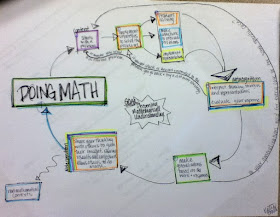 |
| I find it easier to see the hidden figure when I know what I am looking for. (from) |
When I ask teachers to fill out an action plan identifying their current challenge in teaching, I sometimes get comments like these:
- Students are not engaged in the lesson;
- Students do not take good notes;
- Students fail to do quality work;
- Students struggle to apply what we are doing to new situations;
- Students do not engage in productive discussions; or
- Students cannot work well in groups.
My initial response is usually to ask, "Do they know what this looks like?"
This happened recently around the last issue, group work. When I asked the question, the teacher responded as they typically do, "I don't know. I haven't addressed it explicitly." Herein lies the problem; too often we expect students to come to class with certain skills that they do not possess.
As a middle school math teacher, I spent considerable time at the beginning of the school year focusing on fostering skills associated with working effectively in groups. For nearly two weeks the students took part in "plays" representing productive and unproductive groups. After reflecting on these experiences, we created expectation around working in groups that were referred to throughout the rest of the school year. This was time well spent as it allowed me to work with individuals and small groups confident that the remainder of the class knew what was expected of them as they worked together. (It also served another purpose. Near the end of the second week, someone inevitably asked, "When are we going to do math?" Before my two-week bootcamp on groups, students rarely begged to do math.)
Unfortunately, it is not the beginning of the year, and the teachers was looking for something to do now. We brainstormed things that would support the development of productive group work through explicit action. For example, the teacher was tired of constantly reminding the students to get back on task, so I suggested setting a timer that went off at regular intervals as a reminder that they ought to monitor whether or not they were being productive. If students start ignoring the timer, stop the activity and identify some of the positive behaviors exhibited during the activity. Next time an activity involves group work, remind the students of those positive behaviors and try again. Once they complete an entire activity, set the timer for longer and longer periods of time until the students begin to self-monitor their efforts.
What are some examples of ways that you have ensured that your students know what group work (or some other classroom expectation) looks like? I would appreciate your thoughts in the comments so that I can share them with the teachers I am coaching. Thank you in advance for you participation.











